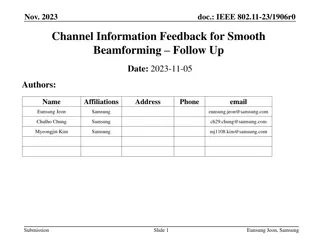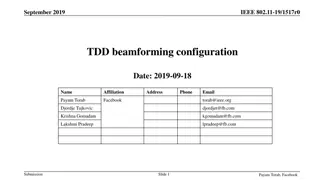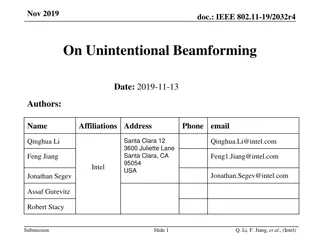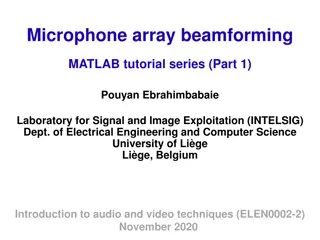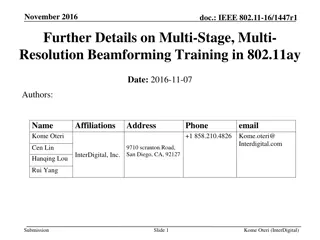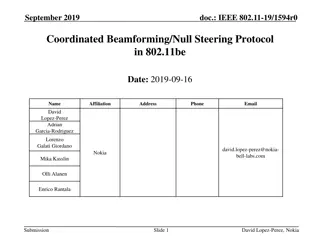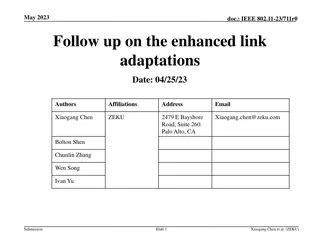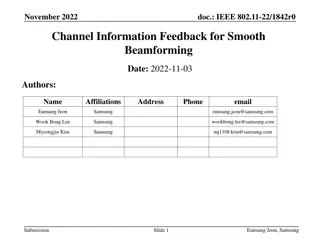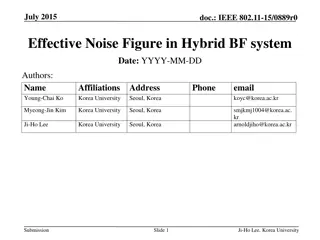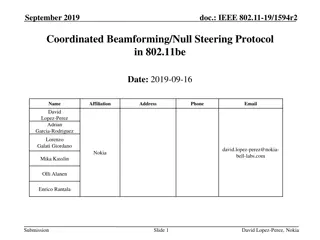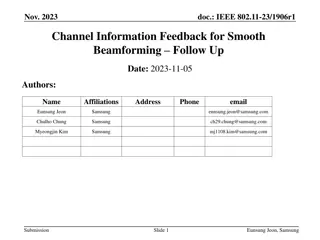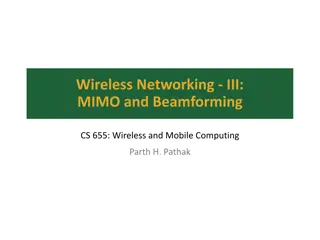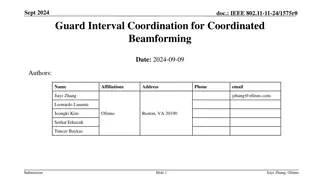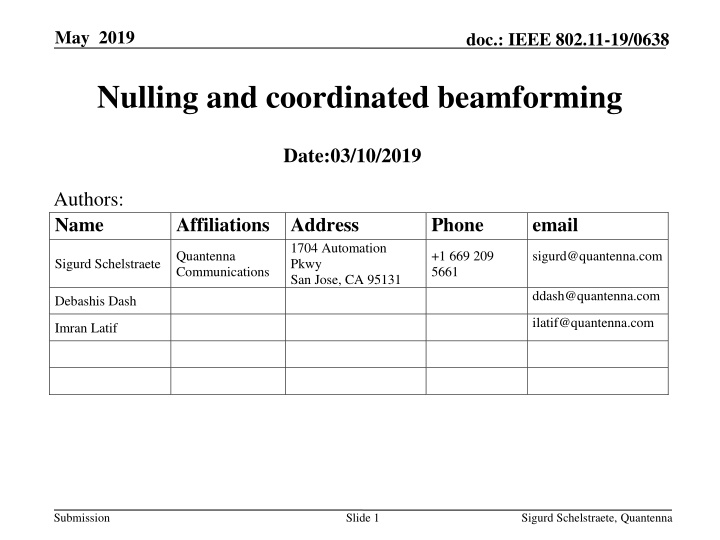
Coordinated Beamforming in IEEE 802.11 Networks
Explore the concept of coordinated beamforming in IEEE 802.11 networks, focusing on nulling techniques to mitigate interference between access points. Learn how digital beamforming is used, the challenges in creating broad nulls, and the implications on signal reception. Verification steps and waveform analysis are discussed in detail.
Download Presentation

Please find below an Image/Link to download the presentation.
The content on the website is provided AS IS for your information and personal use only. It may not be sold, licensed, or shared on other websites without obtaining consent from the author. If you encounter any issues during the download, it is possible that the publisher has removed the file from their server.
You are allowed to download the files provided on this website for personal or commercial use, subject to the condition that they are used lawfully. All files are the property of their respective owners.
The content on the website is provided AS IS for your information and personal use only. It may not be sold, licensed, or shared on other websites without obtaining consent from the author.
E N D
Presentation Transcript
May 2019 doc.: IEEE 802.11-19/0638 Nulling and coordinated beamforming Date:03/10/2019 Authors: Name Affiliations Address Phone email 1704 Automation Pkwy San Jose, CA 95131 Quantenna Communications +1 669 209 5661 sigurd@quantenna.com Sigurd Schelstraete ddash@quantenna.com Debashis Dash ilatif@quantenna.com Imran Latif Submission Slide 1 Sigurd Schelstraete, Quantenna
May 2019 doc.: IEEE 802.11-19/0638 Coordinated BF Coordinated BF was introduced in [1] Independently operating APs creating nulls to avoid mutual interference between OBSS No joint operation Some Channel information exchange needed (not real-time requirement) Submission Slide 2 Sigurd Schelstraete, Quantenna
May 2019 doc.: IEEE 802.11-19/0638 Questions about coordinated BF Which STAs do we null towards? Depending on number of AP antennas, number of simultaneous nulls is limited Can digital BF be used to create a broad null in the general direction of an OBSS? What does a received signal using a nulling precoding matrix really look like? Submission Slide 3 Sigurd Schelstraete, Quantenna
May 2019 doc.: IEEE 802.11-19/0638 Nulling with digital BF Purpose: Verify what the received signal using a nulling precoding matrix really looks like Steps involved in verification: Send an NDP towards a target OBSS STA Collect compressed channel feedback (AP STA channel) Channel D instance Calculate precoding matrices that create null towards the STA Transmit a precoded signal using these precoding matrices and observe the received signal (in the time domain) at the OBSS STA Submission Slide 4 Sigurd Schelstraete, Quantenna
May 2019 doc.: IEEE 802.11-19/0638 Nulled waveform at the receiver Signal is not zero in the time-domain Preamble still arrives at full power (precoding may help) Periodic bursts of energy appear around the symbol transitions, even in part of the signal that is precoded Submission Slide 5 Sigurd Schelstraete, Quantenna
May 2019 doc.: IEEE 802.11-19/0638 Further analysis Precoding assumes circular convolution This assumption is typically not valid inside (most of) the guard interval During the guard interval, signal is not nulled, causing a burst of energy Duration of the burst will depend on length of channel impulse response Submission Slide 6 Sigurd Schelstraete, Quantenna
May 2019 doc.: IEEE 802.11-19/0638 Synchronized system A synchronized system chooses FFT input samples between bursts Nulling still happens in the frequency domain MU-MIMO and BF are naturally synchronized correctly Submission Slide 7 Sigurd Schelstraete, Quantenna
May 2019 doc.: IEEE 802.11-19/0638 Unsynchronized system An unsynchronized system will see interference Even if nulling BF matrices are derived from the correct channel Each symbol corrupted/affected by energy burst In coordinated BF, the victim system and interferer are not synchronized Submission Slide 8 Sigurd Schelstraete, Quantenna
May 2019 doc.: IEEE 802.11-19/0638 Maintaining synchronization Proper synchronization is key to achieving nulling (in the frequency domain) Receiving ( victim ) STA is unsynchronized to the OBSS AP STA synchronizes to a signal being sent to it, not to the interfering signal To have the required synchronization, the transmitting STA needs to synchronize to ongoing transmission STA may learn identity of active transmitter and receiver and can finetune the precoding matrix accordingly No need for broad null or compromise precoding matrix Submission Slide 9 Sigurd Schelstraete, Quantenna
May 2019 doc.: IEEE 802.11-19/0638 Conclusion Nulling using digital BF does not guarantee absence of interference To have nulling, interferer and victim need to be symbol synchronized In that case, canceling happens in the frequency domain Precoding of preamble needs to be considered as well One synchronization mechanism was proposed here Submission Slide 10 Sigurd Schelstraete, Quantenna
May 2019 doc.: IEEE 802.11-19/0638 References [1] Terminology for AP Coordination, IEEE 802.11- 18/1926r2 Submission Slide 11 Sigurd Schelstraete, Quantenna


